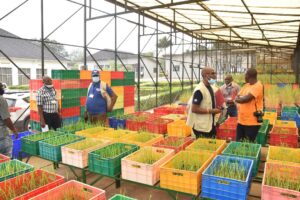Most rice farmers in Kayapa, Nueva Vizcaya, Philippines, grapple with the cold every year. During the summer, maximum temperature peaks at 25.3 °C in May. But, in January, during the cold season, it can drop to 14 °C. To understand better and get a sense of how farmers in high-altitude areas are affected by cold and how they cope with it, let’s look into their stories.
Alternative crop
Herminia Himson, 50, has been a farmer for than 20 years. From mid-February to July, she grows rice for her family’s consumption in the quarter of a hectare she owns in an upland area. However, when the second cropping cycle starts, her farm turns into a vegetable garden. She explains that, since the temperature becomes too cold for her commonly planted rice variety, planting rice during the second season is not an option. When asked what she thinks about cold-tolerant rice varieties, she beams and says, “That would be the best! The rice that we plant during the first cropping is not enough for my family.” For Mrs. Himson, not having meat or vegetables does not matter much as long as there is enough rice for her family to eat.
“Rice is still the more preferred crop to plant,” she adds. “The price of vegetables, such as tomatoes, can fluctuate from three pesos (US$0.064, or less than a cent) to 30 pesos ($0.64).” She recalls a season when her tomatoes rotted in the plots because the cost of harvesting them was even higher than the market price. Given a choice, Mrs. Himson says she would still prefer rice to vegetables because the rice price does not fluctuate as wildly as those of vegetables. Also, being able to plant rice for a second cropping would secure her family’s need for rice. It could also mean having surplus stocks, which they could sell in the market for extra income.
Taking some chances
Not far from Mrs. Himson is another farm, owned by Mr. Wilson Bandro. Wearing a cowboy hat, and maybe a cowboy’s tough heart, too, Mr. Bandro, 50, dares to experiment planting rice on his half-a-hectare land during the second cropping cycle. His patches of rice, growing on terraced land, have varied shades of green because each patch is planted with three different kinds of traditional rice varieties, which are locally known as C1, Galo, and Bongkitan. Mr. Bandro is unsure which of these varieties will cope well with the weather, but he hopes that the prevailing low temperature will not be too cold so his rice can survive.
Like Mrs. Himson, Mr. Bandro also chooses to grow rice over vegetables because the latter is costly. He says vegetables need more capital for inputs such as fertilizer and pesticides, and also more labor. He simply cannot afford these additional expenses. He adds that vegetable gardening is fine if the price is good. If not, then that is another story.
As he shifts his gaze to his patches of rice, which he planted in August, he wistfully says, “Hopefully, I can harvest from these soon.” He cannot, however, help feeling uncertain about his crops. Although the panicles have rice in them, the grains, when pressed, are not yet hard enough. He simply has to wait until harvest time arrives.
Not tending the farm
On the fields of a nearby farm, small pale pink and purple flower heads arise from the branches of Mimosa pudica (sensitive plant) and among other weeds that are creeping, trailing, and standing tall. In between these weeds is the second growth of rice, which grew during the first cropping season—untended and abandoned.
This farm belongs to Jacob Camson, 57. He decided not to plant rice for the second cropping season because he thought that the cold breeze wafting on the highlands might be too cold for rice. He recalled that the last time he planted rice during the second crop cycle—which was years ago—he harvested nothing. Now, he left his farm to overgrown weeds. He says he could have planted vegetables there but finds it too costly.
Farmer-cooperators
Three farmer-cooperators, on the other hand, are looking forward to planting a variety that is suited to their climate as they participate in the National Cooperative Testing for cool elevated area being implemented in collaboration with PhilRice, by Nueva Vizcaya State University (NVSU) through Elbert Sana, NVSU professor, and his team, who brought the breeding lines for evaluation in one of the elevated areas in Kayapa.
According to Roque Martin, a farmer-cooperator, one of his reasons in participating in the field testing is that, if a cold-tolerant line can succeed in their area, he will be the one to benefit first. Then, he can multiply the seeds for his needs.
If other low-temperature areas such as Kayapa were planted with cold-tolerant rice, logically, rice production could be doubled. Farmers could thus help enhance food security in the community and also alleviate poverty.
____________________
Ms. Reyes is the managing editor of Rice Today





